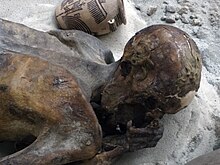35th century BC
Appearance
(Redirected from 3406 BC)
This article has multiple issues. Please help improve it or discuss these issues on the talk page. (Learn how and when to remove these messages)
|
| Millennium |
|---|
| 4th millennium BC |
| Centuries |
| Timelines |
| State leaders |
|
| Decades |
|
| Categories: |
|
Births – Deaths Establishments – Disestablishments |
The 35th century BC in the Near East sees the gradual transition from the Chalcolithic to the Early Bronze Age. Proto-writing enters transitional stage, developing towards writing proper. Wheeled vehicles are now known beyond Mesopotamia, having spread north of the Caucasus and to Europe.
Cultures
[edit]
- Susa (Iran since 7000 BC)
- Uruk period (Sumer)
- Naqada IIb (Ancient Egypt)
- Early Minoan I
- Sredny Stog culture (final phase)
- Yamna culture (early phase)
- Cucuteni culture
- Vinča culture
- Megalithic Europe (Atlantic fringe)
- Nuragic civilization (Sardinia)
- Comb Ceramic culture
- Funnelbeaker culture
- Yangshao culture
Artifacts
[edit]Only approximate dating is usually possible for mid-4th millennium artifacts.
Events
[edit]- The Sahara desert starts to form from semi-arid savannah, through desertification.
- c. 3500 BC: First known zoo at Hierakonpolis.[1]
- c. 3400 BC: Sumerian temple record keepers redesign the stamp seal in the form of a cylinder.
- c. 3500 BC: Pictographic proto-writing starts developing towards writing proper in Sumer, thus starting what is technically considered history.
- c. 3500 BC: The first monument of which there is still a trace (Duma na nGiall) is built on the Hill of Tara, the ancient seat of the High King of Ireland.[2]
- c. 3500 BC: Tin is discovered.
- c. 3500 BC: The Eruption of Mount Isarog in the Philippines.[3]
- c. 3500 BC: The Sumerians develop a logographic script, cuneiform
- c. 3484 BC: The oldest estimated germination of Alerce Milenario with more conservative dates of only ‘c.1653 BC’.[4]
Sovereign states
[edit]References
[edit]- ^ World's First Zoo - Hierakonpolis, Egypt, Archaeology Magazine, http://www.archaeology.org/1001/topten/egypt.html Archived 2010-07-12 at the Wayback Machine
- ^ Memory and Monuments at the Hill of Tara by Erin McDonald, Chronika Journal
- ^ "Global Volcanism Program | Isarog". Smithsonian Institution | Global Volcanism Program. Retrieved 2021-01-22.
- ^ POPKIN, GABRIEL (2022-05-20). "Is the world's oldest tree growing in a ravine in Chile?". www.science.org.
